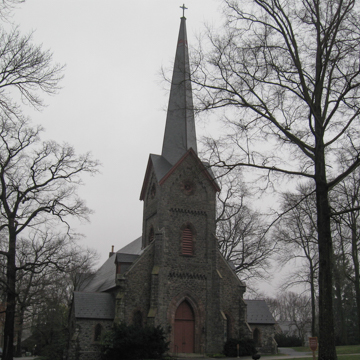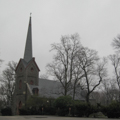The first generation of du Ponts in America were Deists, but Victorine became a devout Anglican. From her Brandywine Manufacturers' Sunday School (CH15.3) grew this Episcopal congregation, in which pious Alexis I. du Pont (see St. John, WL54) and Captain Samuel Francis Du Pont were active. After considering architect Richard Upjohn, the captain commissioned English-born Gilpin, a Philadelphia architect and railroad engineer known for rebuilding the Pennsylvania Academy of the Fine Arts after a fire in 1845, to design a stone, buttressed, Gothic Revival church in an oak grove. The soaring, needlelike spire was hoisted in November 1855—knocking off a chimney in the process—and the following April, it was modified with tiny windows for the view, as suggested by Lammot du Pont. Alexis was high-church in his leanings, and debates arose about the chancel arrangement and having a cross on the steeple. Ironically, his was the first funeral here, as he died in a powder-yard blast in 1857. Later explosions, in 1890 and 1920, smashed the lattice-light lancet windows (replaced the second time by Henry Wynd Young of New York City).
The present interior dates to 1914–1915, the alterations overseen by Henry Francis du Pont of Winterthur (CH10), a lifelong member. The parishioners credited “his excellent taste and judgment” and approved the removal of nineteenth-century pews and other trappings: “Gone the hideousness of golden oak!” The truss ceiling has hammerbeams enriched with angel heads in English medieval style. Red sandstone replaced the original plaster for the chancel columns and, in 1929, for the chancel's Gothic arches. President Franklin D. Roosevelt attended the wedding of his son to Ethel du Pont (of Owl's Nest, CH5) here in 1937, one of countless society weddings the church has witnessed. Children's Chapel, by a Philadelphia architect, has decorative painting on the truss ceiling and child-scaled pews by Philadelphian George Ciukurescu. The base of Christ Church tower has been partially enclosed by additions (1957, 2007) that skillfully blend with the original walls.







